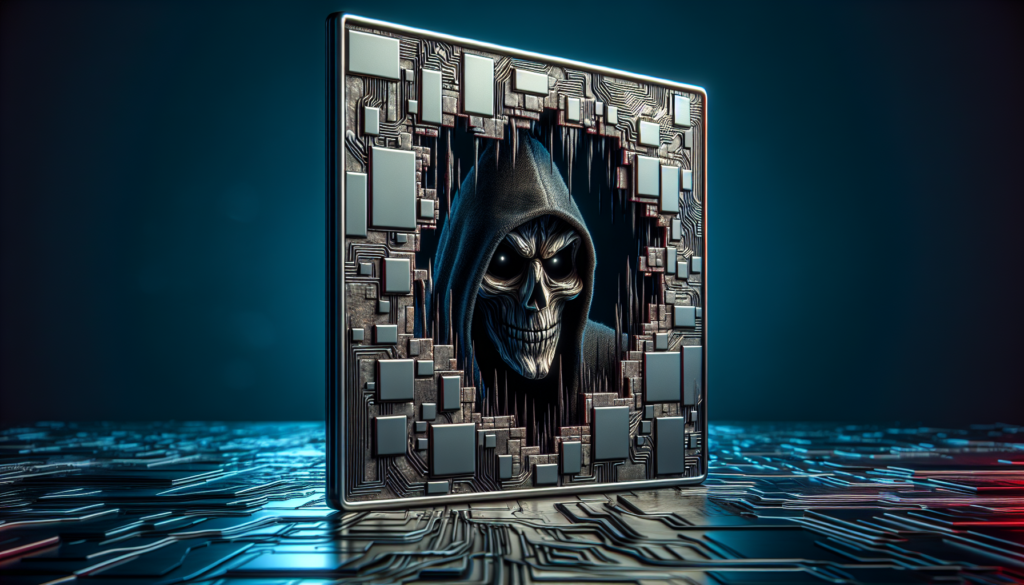Imagine a world where cybercriminals have the power to infiltrate your devices undetected, stealing your personal information, and wreaking havoc on your digital life. This is the reality we face with the rise of rootkits, a stealthy and dangerous form of cyber threat. In this article, we will unravel the mysteries of rootkits, shedding light on their elusive nature and exploring the potential damage they can cause. Brace yourself for an eye-opening journey into the world of rootkits, where knowledge is power.

What is a Rootkit?
Definition
A rootkit is a type of malicious software that is designed to gain unauthorized access to a computer system or network and remain undetected. It is essentially a stealthy tool used by hackers to maintain control over compromised systems, allowing them to perform illicit activities without being detected. Rootkits are among the most sophisticated and dangerous types of malware, as they can manipulate the operating system and evade traditional security measures.
Functionality
The primary function of a rootkit is to hide its presence and activities from the user and security software. Once installed on a system, a rootkit typically establishes a hidden and privileged presence, granting the attacker complete control over the compromised device. This control allows the attacker to execute various malicious activities, such as stealing sensitive data, monitoring user activity, modifying system configurations, or even launching further attacks on other systems.
History of Rootkits
Early rootkits
Rootkits have a long history that traces back to the early days of computing. One of the first documented rootkits was the “The Unix Rootkit” developed by Ken Thompson, one of the creators of the Unix operating system, in the early 1980s. This rootkit exploited vulnerabilities in the Unix compiler and libraries to gain unauthorized root access.
Modern rootkits
With the rapid advancement of technology and the increasing interconnectedness of systems, rootkits have evolved significantly over the years. Modern rootkits are now capable of infecting various operating systems, including Windows, macOS, and Linux. They have become more sophisticated and employ advanced techniques to evade detection and maintain persistence on infected systems.

How Rootkits Work
Infection process
Rootkits typically gain access to a system through various means, such as email attachments, malicious downloads, or vulnerabilities in software. Once a rootkit infects a system, it establishes a presence that allows it to survive reboots and remain hidden from traditional anti-malware scanners.
Masking and hiding techniques
One of the key features of rootkits is their ability to conceal their presence and activities on an infected system. They achieve this by manipulating the operating system at different levels. User-mode rootkits, for example, operate at the user level and modify system files, processes, or libraries to hide their presence. Kernel-mode rootkits, on the other hand, manipulate the operating system’s kernel, allowing them to intercept and modify system calls, making it extremely difficult to detect their presence.
Privilege escalation
Rootkits often exploit vulnerabilities in the operating system or applications to gain elevated privileges on a compromised system. By exploiting these vulnerabilities, they can escalate their access from a user-level account to a privileged account, such as an administrator or root user. Once privileged access is obtained, the rootkit has the ability to control and manipulate the system at a deeper level.
Types of Rootkits
User-mode Rootkits
User-mode rootkits operate at the user level within an operating system. They modify user-space processes, libraries, or configurations to hide their presence and manipulate system behavior. User-mode rootkits are relatively easier to detect compared to kernel-mode rootkits but still pose a significant threat to the infected system.
Kernel-mode Rootkits
Kernel-mode rootkits work at a much deeper level within an operating system. They manipulate the operating system’s kernel, allowing them to intercept and modify system calls, device drivers, or other critical components. Kernel-mode rootkits are notoriously difficult to detect and remove, requiring advanced techniques and tools specifically designed to combat them.
Bootkits
Bootkits are a specialized type of rootkit that infects the boot process of a computer system. By infecting the Master Boot Record (MBR) or the boot loader, bootkits gain control over the system from the early stages of booting. This allows them to load before the operating system and evade most security mechanisms. Bootkits can persist even after reinstalling the operating system and are notoriously difficult to remove.
Hardware or Firmware Rootkits
Hardware or firmware rootkits reside within the physical components of a computer system, such as the motherboard, BIOS, or network card firmware. These rootkits can manipulate the firmware to gain control over the system and evade detection at the software level. Hardware or firmware rootkits are challenging to detect and remove, often requiring specialized tools and expertise.

Common Symptoms of Rootkit Infections
Unusual system behavior
One of the common indicators of a rootkit infection is unusual or unexpected behavior exhibited by the infected system. This can include sudden crashes, freezes, or unresponsive applications. The rootkit’s presence can also cause system instability and erratic behavior.
Slow performance
Rootkits consume system resources and can cause a significant decrease in system performance. Infected systems may experience slow startup and shutdown times, sluggishness when running applications, or increased response times for basic operations.
Unexpected network activity
Rootkits often establish command-and-control channels with external servers, allowing attackers to remotely control the compromised system. This communication can result in unexpected network activity, such as high data transfer volumes, connections to suspicious IP addresses, or unusual network traffic patterns.
Detection and Removal of Rootkits
Antivirus software
Traditional antivirus software can be effective in detecting and removing certain types of rootkits. While they may not be able to detect more advanced or stealthy rootkits, regularly updating and running antivirus scans can help mitigate the risk of infection and identify known rootkit variants.
Rootkit detection tools
Specialized rootkit detection tools are available that focus specifically on identifying and removing rootkits. These tools employ advanced techniques to detect and analyze rootkit behavior and can be effective in detecting even the most sophisticated rootkits. Examples of such tools include GMER, Rootkit Remover, and RootkitRevealer.
Manual discovery and removal
Manually discovering and removing a rootkit is a complex and delicate process that requires in-depth knowledge of rootkit behavior and system internals. It involves analyzing system logs, identifying suspicious processes or files, and manually removing the rootkit components. Manual removal should only be attempted by experienced security professionals.

Preventing Rootkit Infections
Updating operating systems and applications
Regularly updating operating systems and applications is a crucial step in preventing rootkit infections. Software updates often include security patches that address vulnerabilities exploited by rootkits. Keeping systems up to date ensures that known vulnerabilities are patched and reduces the risk of successful rootkit infections.
Using strong passwords and authentication methods
One common method used by attackers to gain unauthorized access to systems is through weak passwords or authentication mechanisms. Using strong, unique passwords and enabling two-factor authentication can significantly reduce the risk of rootkit infections by making it more difficult for attackers to gain unauthorized access.
Regularly scanning for malware
Performing regular malware scans on systems using up-to-date antivirus software or specialized rootkit detection tools can help identify and remove rootkits before they can cause significant damage. Regular scans should be part of a comprehensive cybersecurity strategy to ensure early detection and mitigation of any potential rootkit infections.
Famous Rootkit Attacks
Sony BMG copy protection rootkit
In 2005, Sony BMG, a major record label, distributed music CDs that included a copy protection rootkit. This rootkit installed itself on users’ computers without consent and compromised system security. The Sony BMG rootkit sparked widespread controversy and legal action, highlighting the potential harm that rootkits can cause to innocent users.
Stuxnet malware
Stuxnet, discovered in 2010, was a highly sophisticated rootkit that targeted industrial control systems, specifically those used in the Iranian nuclear program. It infected systems using multiple zero-day vulnerabilities and caused physical damage to centrifuges by manipulating their control software. Stuxnet demonstrated the capability of rootkits to cause real-world damage and highlighted their potential as advanced cyber weapons.
Duqu rootkit
Duqu, discovered in 2011, was a state-sponsored rootkit designed to gather intelligence from targeted organizations. It infected systems through targeted phishing attacks and exploited zero-day vulnerabilities. Duqu shared similarities with the Stuxnet malware and raised concerns about the use of rootkits by nation-state actors for espionage purposes.

Legal and Ethical Implications
Unlawful use of rootkits
The use of rootkits for malicious purposes, such as unauthorized access, data theft, or system manipulation, is illegal in most jurisdictions. Rootkit attacks can lead to severe legal consequences, including criminal charges and significant financial penalties. It is important to emphasize that the use of rootkits is strictly limited to authorized security research, law enforcement, or defensive purposes.
Ethical considerations for using rootkits in security research
While rootkits are primarily seen as malicious tools, there are ethical considerations when it comes to using rootkits for security research. Ethical researchers may utilize rootkits to study their behavior, identify vulnerabilities, and develop countermeasures. However, it is essential that such research is conducted ethically and in accordance with the law, with the intent to enhance cybersecurity and protect systems and users.
Conclusion
Understanding rootkits is of critical importance in the constantly evolving landscape of cybersecurity. Rootkits represent a potent threat that can compromise system security, privacy, and integrity. By being aware of their existence, functionality, and detection methods, individuals and organizations can better protect their systems and data from potential rootkit infections. As technology continues to advance, rootkits will likely evolve and become even more sophisticated, making it essential to stay vigilant and continuously update security measures to mitigate the risks associated with this sneaky cyber threat.

